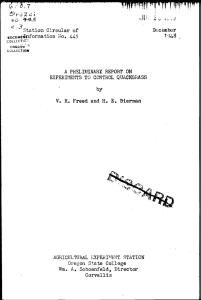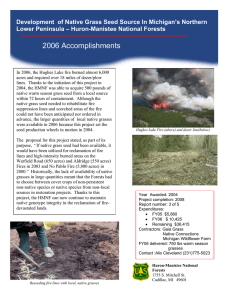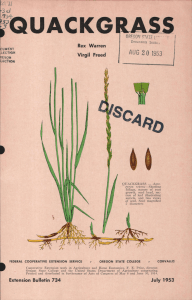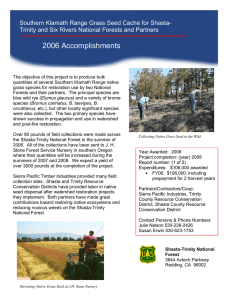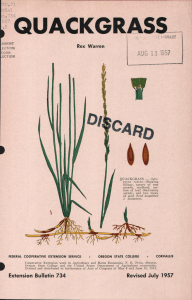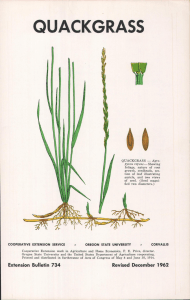Quackgrass Oregon State System of Higher Education Federal Cooperative Extension Service
advertisement
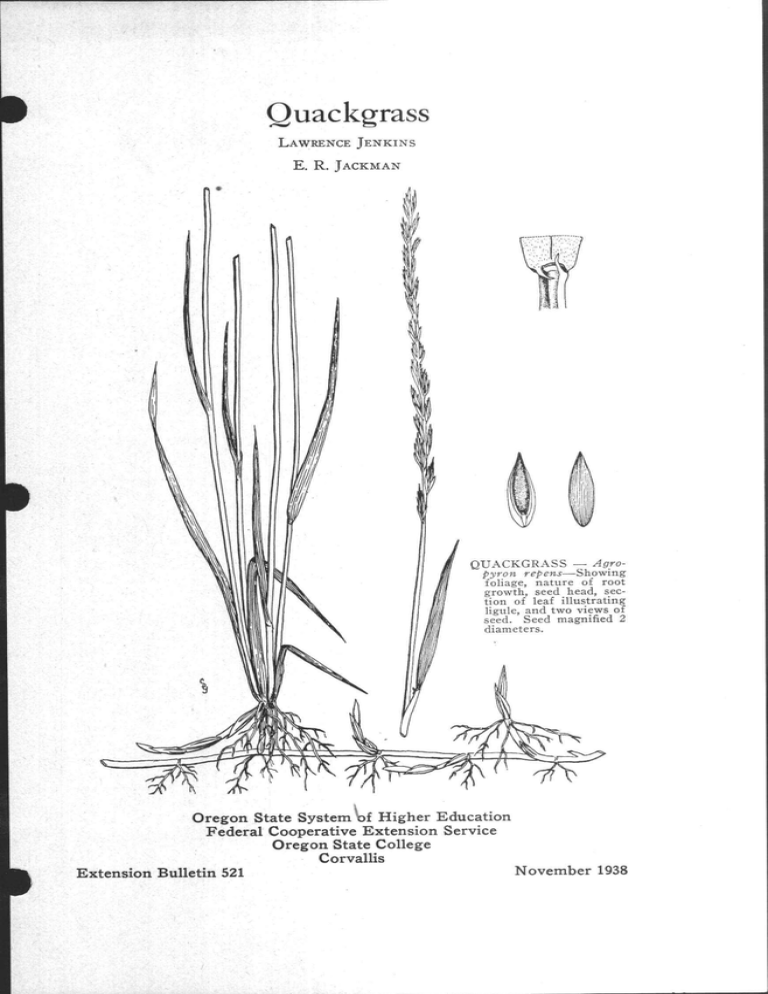
Quackgrass LAWRENCE JENKINS E. R. JACKMAN QUACKGRASS Agro- pyron repensShowing foliage, nature of root growth, seed head, section of leaf illustrating ligule, and two views of Seed magnified 2 diameters. seed. Oregon State System of Higher Education Federal Cooperative Extension Service Oregon State College Corvallis Extension Bulletin 521 November 1938 Quackgrass (Agropyron rep ens) By LAWRENCE JENKINS and E. R. JACKMAN* Illustrations by Cathrine Davis Young Other names: Couch grass, Wheat grass, Witch grass. UACKGRASS is found in nearly all sections of the state and adapts itself to almost any soil type but it is more prolific on irrigated lands or moist bottom lands. Quackgrass is not an arid-climate weed and is seldom found in Oregon in areas with less than 12 inches of rain except on creek bottoms or subirrigated land. It is a grass which produces a fair quality of forage and hay and is one of the best soil binders. Quackgrass is a serious weed pest where not wanted because it spreads rapidly and tends to take complete possession of any field where it establishes itself. Other grasses with spreading rootstocks are erroneously called quackgrass. Some of these found in Oregon are: Western wheat grass (Agropyron smithii), Johnson grass, Canada bluegrass, and Beardless wild-rye. Quackgrass has the following characteristics: (1) The young leaf blades of quackgrass often have at the base, or where the leaf and stem join, a pair of claw-like appendages (called ligules) extending around the stem (see picture). These claws are characteristic of quackgrass, barley, wheat and a few of the rye grasses, but are on few other grasses. (2) The seed heads resemble those of rye grass, but the groups of seed, which are formed like wheat, are attached with their flat sides against the stem, while in rye grass they are attached with the narrow side toward the stem. The head of quackgrass is about the same length as wheat but the seeds are not nearly so plump. (3) The rootstocks of quackgrass are long, slender, cord-like, yellowish white structures, about inch in diameter, smooth, bare, and hollow except at the joints where they are solid and covered with scaly leaf-like structures. Most of the rootstocks are within eight inches of the surface. The tips of the rootstocks are provided with sharp hard points which enable them to penetrate a potato, the hardest soil, or even a piece of wood. The rootstocks are not like true roots, but bear true roots at the joints, where branches also form. These branches may become rootstocks or may turn into shoots that form plants above ground. The life of the individual rootstock is reported by the United States Department of Agriculturet to be only 15 months or less, but the formation of new rootstocks is rapid and continuous in early spring and in the fall, if moisture is available. The seeds resemble oats and other long seeded grasses such as rye grass, crested wheat grass and brome grass. It is difficult to separate seed of quackgrass from seed of the grasses mentioned. Oregon seed law. The Oregon seed law classes quackgrass as a noxious weed. If any small seeds are sold containing quackgrass seed, the amount must be mentioned on the label. In addition, it is illegal to sell seed containing more than 9 or 18 seeds of quackgrass per pound, the amount depending upon whether the crop seed is large or small. * E. R. Jackman is Extension Specialist in Farm Crops and Lawrence Jenkins is Assistant Specialist in Farm Crops at Oregon State College. t Quackgrass, United States Department of Agriculture Farmers' Bulletin 1307. 2 Method of spread. Quackgrass usually arrives on a farm in grain or grass seed, but it is spread mainly by plowing through patches and spreading the rootstocks. Each piece of rootstock with a joint is capable of producing a new plant. Since much of the immature seed will grow, quackgrass hay also spreads the plant. Damage. The greatest damage is in increased cost of farming. It was estimated in 1937 that the weed had complete possession of 20,000 acres of land in Oregon and was present to a less extent on many thousands of other acres. Control by cultivation. The most widely used control method on large areas is to plow the infested area in June, without mold boards or with mold boards that will leave the furrow slice as nearly on edge as possible. The land should be 1k 11 iW left in this rough condi- kv be killed with this treatment. After the exposed roots have dried out, the \I if tion for 2 weeks to dry out. Many of the rootstocks will land should be disked down and gone over with a har- row or springtooth that will pull up. many roots. The rootstocks should then A be raked and burned. This system followed by clean Seed heads of grasses commonly confused with Quackgrass. fallow the remainder of the A. Western Wheat GrassAgropyron snatnii season will usually eradiB. Canada BluegrassPoe compressa C. Beardless Wild-RyeElyozus triticoides cate the pest. ,The following year the land should be planted to a cultivated crop and any patches that show up should be dug out, hoed, or cultivated frequently until the weed is entirely eradicated. Deferred fallow works well with quackgrass except in the highest elevation farming areas in the state. For deferred fallow in Eastern Oregon plant winter wheat or winter rye with at least double the usual rate of seeding, cut for hay in the early milk stage, and plow at once. Work up the soil, drag out and burn the roots, then cultivate. If any live roots are found in the fall, repeat another year. For Western Oregon, use vetch or winter barley for this purpose. Often one year of this treatment will rid the land of the grass. Cultivation during dry, hot weather is more effective than in cool weather or when the soil is moist. The dry summers of Oregon make control by cultivation easier than in states with summer rainfall. The seeds are not long lived in the soil and once a patch is eliminated it is seldom that reinfestation occurs through buried seeds. Killing is easier if the area has been pastured or cut off frequently for a couple of years preceding cultivation. Frequent removal of the top growth reduces the root area and tends to concentrate the roots close to the surface. 3 Control by chemicals. Sodium chlorate has not been so effective on quackgrass as on morning-glory and most other weeds. The roots are shallow and irrigation or abundant rain will wash the chemical into the subsoil and leave live roots near the surface uninjured. There have been many cases of success, however. It should be applied in the fall in Eastern Oregon and in the spring in Western Oregon at the rate of 2 pounds per square rod. Chlorate chemicals are dangerous unless proper precautions are observed. See pages 15 to 23 in Oregon Extension Bulletin 510 for further information and, especially, pages 19 to 22 on precautions. Carbon bisulphide is not effective on quackgrass due to the many roots close to the surface. Other control methods. Pasturing quackgrass will make control easier by cultivation or by chlorates, but will not kill the weed. In moist soils the grass is an excellent pasture plant and many people use it for that purpose, believing that it provides nearly as much pasture as domestic grasses. Row crops coupled with liberal and frequent use of the hoe will eradicate quackgrass in two years, as a rule. Sunflowers are most effective, but check-rowed corn is used frequently. Potatoes or beans are not so effective because in the late season it is difficult to hoe close to the plants, and they do not provide complete shade. Seeding the land to perennial crops, such as alfalfa or grass, is not at all effective and neither is close mowing, although both tend to move the rootstocks into the top soil. Although the root system of this weed is shallow, and it is easier killed by cultivation or by hoeing than are most perennials, it is more difficult to control by most other common methods. A few growers have achieved control by covering the weed with straw for two or three seasons and then burning the straw. The roots tend to creep into the rotting straw at the surface of the ground where a hot fire may kill most of them. Hand digging has been practiced with success by many growers. It is more feasible than with deeper rooted weeds. Spraying with fuel oil at the rate of 2 to 3 gallons per square rod will prevent seed formation and if repeated often enough will eventually kill a patch. This may be the most practical control measure when cultivation is impossible. Fall planted crops resist the weed better than those planted in the spring. With any treatment be sure to kill the last plant or growth will reappear and soon cover the entire area again. For further information on control methods and general information about weed control, read Oregon Extension Bulletin 510, "Control of Perennial Weeds in Oregon." This is one of a series of 39 bulletins discussing 58 perennial weeds in Oregon and their control. A list of bulletins in this series will be found on the last page of Extension Bulletin 510. The individual bulletins are punched so that several may be bound together if desired. ACKNOWLEDGMENTS: The authors thank Dr. Helen M. Gilkey, Curator of the Herbarium, for reading the manuscript and checking the description of the plant. Professor G. R. Hyslop, In Charge, Division of Plant Industries, made many helpful suggestions. Cooperative Extension Work in Agriculture and Home Economics Wm. A. Schoenfeld, Director Oregon State College and United States Department of Agriculture, Cooperating Printed and distributed in furtherance of the Acts of Congress of May 8 and June 30, 1914 4
